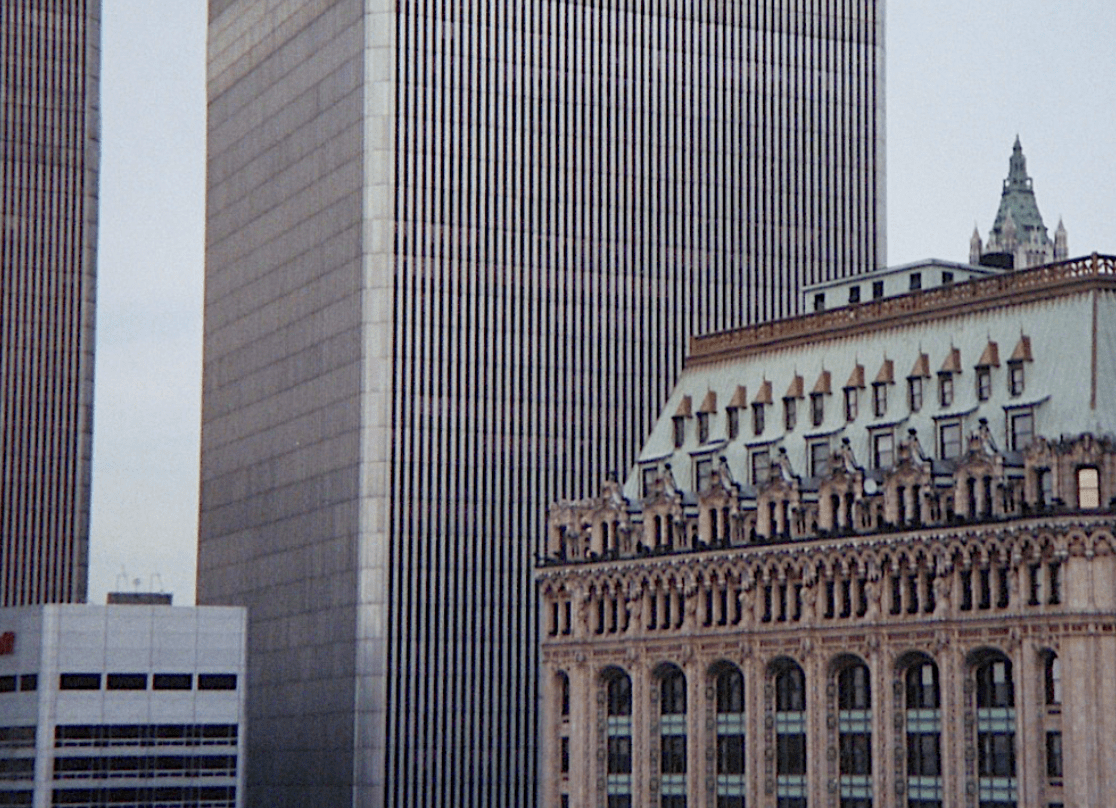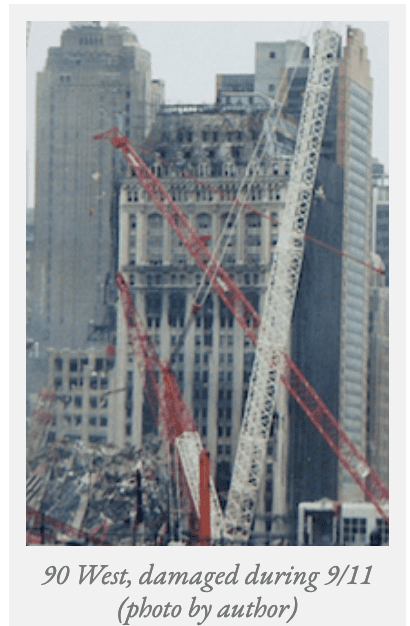Search Posts
Recent Posts
- Outdoors in RI: The million dollar Penguins are here, Paws off the wildlife, Beach ready… May 23, 2025
- The MAHA Report: Step 1. What did they do to our children – the sickest generation in history May 23, 2025
- Rhode Islanders shred 22,000+ pounds of sensitive docs at Navigant Credit Union events May 23, 2025
- Rhode Island Weather for May 23, 2025 – Jack Donnelly May 23, 2025
- Rhode Island Weather for May 22, 2025 – Jack Donnelly May 22, 2025
Categories
Subscribe!
Thanks for subscribing! Please check your email for further instructions.

9/11 revisited, 20 years on – David Brussat
by David Brussat, Architecture Here and There
Photo: 90 West St. (right), at Ground Zero in Lower Manhattan, circa 1995. (photo by author)
I saw 9/11 as it was happening on a TV screen through one of the large windows of URI’s Providence campus (the Shepard Building) facing Union Street. I was on my way to work at the Journal – two blocks from my downtown loft – where I saw the two buildings, Tower 1 and Tower 2 of the World Trade Center, topple. Two weeks later I visited the scene and wrote “Peering into the towering abyss.”
I was determined to learn whether one of my favorite buildings, a 1905 Beaux Arts tower at 90 West St. on the edge of Ground Zero, had survived. Finally I saw it. It had been damaged but was still standing, still beautiful. In my column from a couple of weeks after 9/11, I noted that for all their symbolic resonance after their demolition, few considered the twin towers beautiful. My conclusion:

Perhaps buildings, like people, can attain greatness if not beauty in death. Many people shrink from the idea of building tall again. I do not know whether the towers should be rebuilt. A colleague says that would be to court a repeat disaster: Imagine two buildings each with 110 13th floors. Only a lunatic would rent space or take a job there.
Well, I’m not sure I agree. Maybe the murder of these two buildings, and their thousands of occupants and hundreds of rescuing heroes, can generate enough unity and strength of purpose in the civilized world to vanquish terrorism. Maybe then we can rest easy, build big, live large and watch the spirit of two buildings rise from tallness to greatness. Abraham Lincoln was no beauty, either.
Since then I have written many columns and blog posts about rebuilding Ground Zero but none about the terrorist attack on America or America’s wars launched in response to these despicable acts. Three thousand Americans died on 9/11 and more thousands of U.S. soldiers have died in Afghanistan and Iraq. We are still in Iraq, minimally, and have just left Afghanistan, ignominiously. There has been no second major terrorist attack, but after rapid wins in both wars, U.S. and allied forces lost focus and have been in surrender mode for years.
We’ve now withdrawn suddenly from Afghanistan, a withdrawal President Biden is calling a victory. His willful obtuseness only deepens the national humiliation.
I have written no columns or blog posts about how America has changed since 9/11. It is not my gig, but I do have my feelings, which grumble occasionally and tangentially in my posts. Life in America has eroded, and America’s prestige in the world has declined. Some people find that worthy of applause. Not me.
Large sectors of the nation have officially embraced themes that demonize our citizens, our history, and the principles of our founding. And in addressing the pandemic, our first impulse was to surrender. We shut down our economy, increasing the pandemic’s cost without controlling it. It may be argued that we are not a free country anymore, that the nation lacks a working constitution, not to mention a free and independent press, and that the last election was stolen.
Censorship – official, unofficial and self – has largely voided conversation throughout society on the subjects that divide us. The unity we pretend to seek is a joke.
This is a sad indictment of America since 9/11. My gig is architecture, and in architecture things seem no better. Developers continue to construct faceless buildings whose gargantuan size and cold sterility only reinforce authoritarian themes present in our politics and our response to the pandemic. A movement toward a living architecture has managed to carve out a beachhead in the field. It is based on neurobiological discoveries that explain the public’s broad traditional preferences. But classical architects and their advocates are too timid to embrace their very rare opportunities to confront the modernist establishment.
Naysayers used to warn after 9/11 when a policy of caution was advised: the terrorists have already won! I hope not. I like the spirit of Flight No. 93, whose hijacked passengers forced it to crash in a Pennsylvania field on its away to attack either the U.S. Capitol or the White House. As he and fellow hijacked passengers charged the cockpit, Todd Beamer is said to have cried “Let’s roll!” Something like that can-do (indeed, must-do) spirit might be useful in America today.
To read the full column: https://architecturehereandthere.com/2021/09/11/9-11-revisited-20-years-on/
To read more columns Brussat has written for RINewsToday: https://rinewstoday.com/david-brussat-contributing-writer/
_____

My freelance writing and editing on architecture and others addresses issues of design and culture locally and globally. I am a member of the board of the New England chapter of the Institute of Classical Architecture & Art, which bestowed an Arthur Ross Award on me in 2002. I work from Providence, R.I., where I live with my wife Victoria, my son Billy and our cat Gato. If you would like to employ my writing and editing to improve your work, please email me at my consultancy, [email protected], or call (401) 351-0457 https://architecturehereandthere.com/
